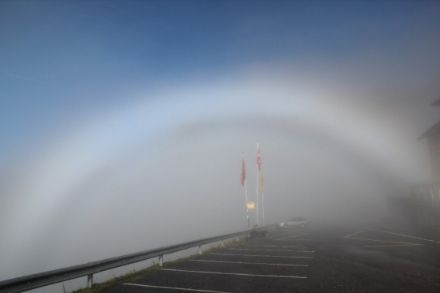Service Navigation
Search
What distinguishes fog bows from rainbows?
The fog bow is markedly wider than a rainbow and has a yellowish shimmer on its outside edge and a bluish shimmer on the inside. In between the two edges it is white. A slightly darker zone is usually followed by one or two more arcs on the inside. These are the interference arcs. Fog bows are created by refraction and reflection of light from water droplets suspended in the air.

The droplet size can be directly determined from the colouring of the fog bow. In the picture above, this is around 25 μm (0.025 mm) or less. If the droplet size falls below 5 μm (0.005 mm), the fog bow is no longer visible.
However, the phenomenon of fog bows cannot be explained by refraction and reflection of light alone; more importantly, the wave nature of light must be taken into account. The underlying physics can be found in the bibliography under the keywords "diffraction and interference" or on the internet .
Rainbow
Rainbows are the best-known light phenomenon in the sky. They are created by refraction and reflection of light from raindrops, the size of which ranges from 0.25 to about 3 mm in normal rain.
